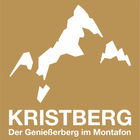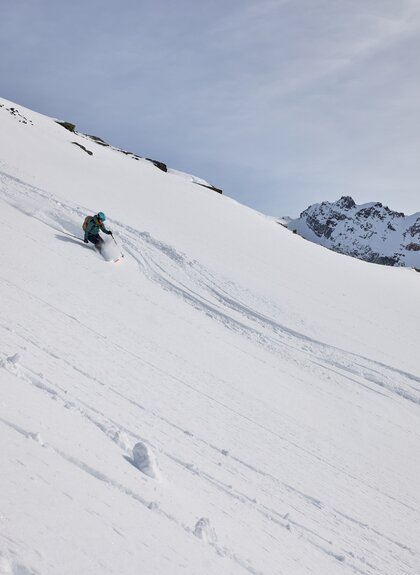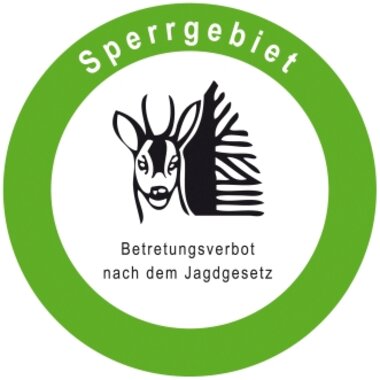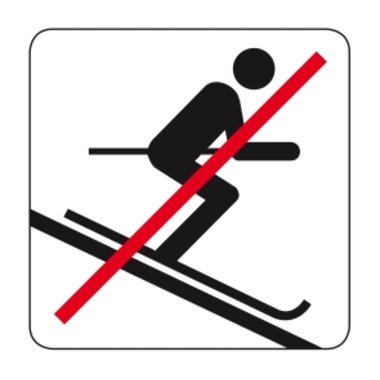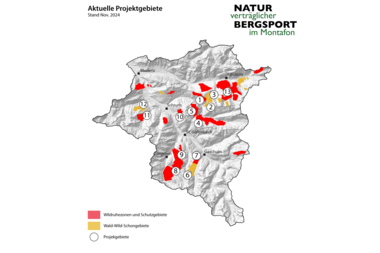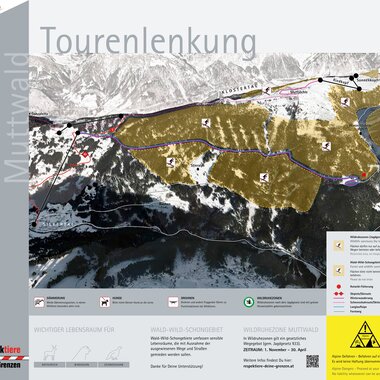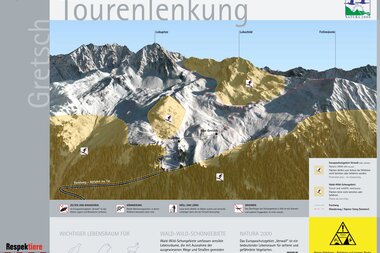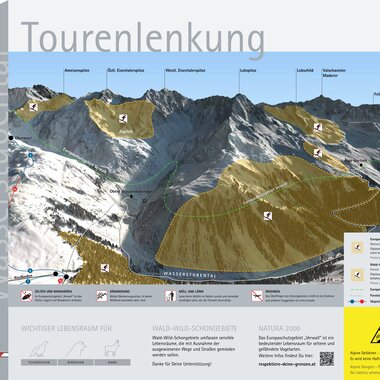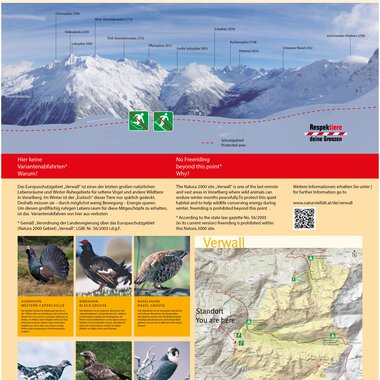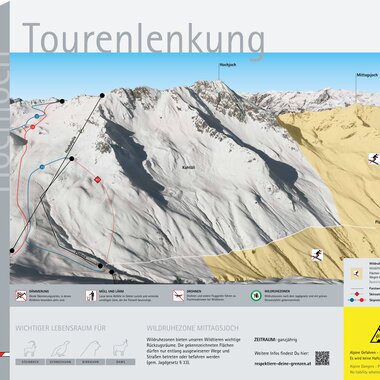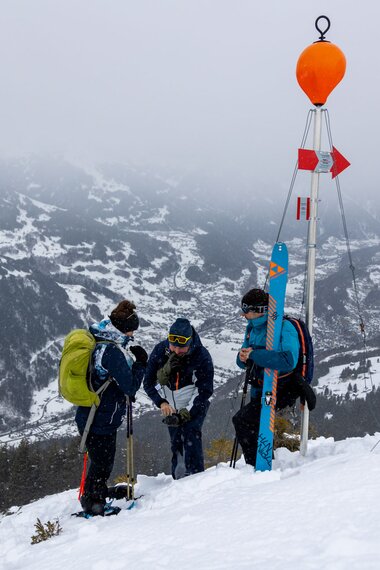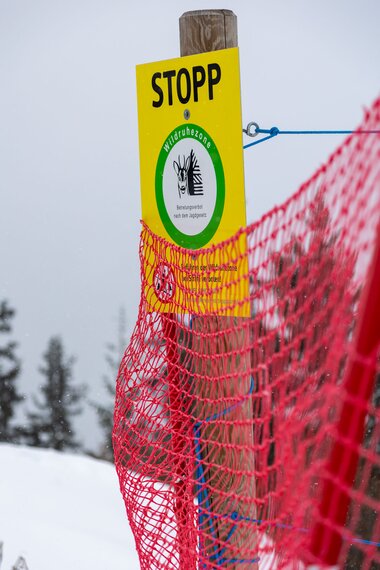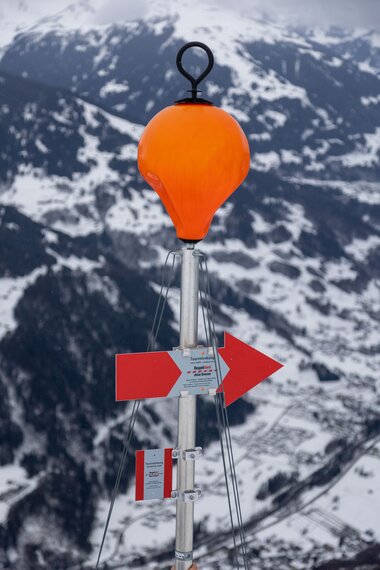Nature-friendly winter sports
The "Nature-friendly mountain sports in the Montafon" initiative has its origins in winter - where the pressure on sensitive habitats is particularly evident. This is because wild animals are particularly sensitive to disturbance during the cold season, and forests and soils are also in a vulnerable dormant phase.
The aim of the initiative is to enable off-piste winter sports in harmony with nature and habitats - through dialog, awareness-raising and concrete solutions on the ground.
Rules in the open ski area
Wildlife rest areas, restricted hunting areas, young growth areas - with the abundance of different regulations, it is admittedly easy to lose track. So that you are always "safe" on your off-piste tour, you will find a brief summary of the applicable regulations here.
Skiing in Open Terrain
Outside of forest areas, winter sports equipment is permitted if there is enough snow - as long as the areas are not fenced in or closed off by signs such as "Respect your boundaries" or other measures.
Wildlife Rest Areas, Hunting Restriction Zones and Other Protected Areas
Wildlife quiet zones are intended to preserve areas of retreat for our wild animals in areas that are particularly prone to disturbance. In these sensitive zones, a general road ban applies. Snowshoe hikes and ski tours may therefore only be undertaken along designated roads and paths. Game feeding stations should be avoided within a radius of 300 m.
Wildlife rest areas and restricted hunting areas are specially marked with green signs.
In addition to game rest zones and restricted hunting areas, there are other protected areas with relevant regulations for winter sports, such as the "Verwall" European nature reserve or the "Vergalden" rest zone.
Ski Runs through the Forest
In general, there is free access to the forest. However, in the area of lifts* or ski lifts, skiing in the forest is only permitted on marked pistes and ski routes. Young forest areas with vegetation less than 3 m high may not be entered. This ensures new growth and reforestation.
Be careful - the above regulations in the forest do not require any special marking in the terrain.
*The "area of ascent aids" is the distance that can be reached from the mountain station of an ascent aid without having to walk for thirty minutes, but in any case an area of 500 m on both sides of the ascent aid, slope or marked descent.
Forest and Wildlife Conservation Areas
For selected areas in the Montafon and Klostertal, user groups, landowners and managers have agreed on areas that should be avoided by winter sports enthusiasts in order to protect forest areas and wildlife. These so-called forest-wildlife conservation areas are intended to ensure that areas can generally continue to be used for winter sports.
By adhering to these agreements, you are also helping to preserve the basis of life for wildlife and forests.
IMPORTANT : Compliance with the agreements is evaluated on an ongoing basis and changes may be made in the next season if necessary. Please keep yourself up to date!
Maps
You can find the maps of all prescribed wildlife rest areas, protected and restricted areas in the Vorarlberg Atlas.
Info
You can find more information on correct behavior in nature at Respect your limits.
Current project areas
1st Muttwald
A management concept has been in place for the Muttwald for a number of years in collaboration with the Austrian Alpine Association. In the period from 1 November to 30 April, the "Muttwald" wildlife rest area is only open for winter sports along the designated corridor. Information boards are located at the Kristbergbahn valley station, along the ascent route and at the summit of the Muttjöchle. Individual orientation aids can be found along the corridors.
2. Gretsch
For ski tours in the area of Alpe Gretsch (Lobspitze, Fellimännle), ski down the forest path from Alpe Gretsch into the Wasserstubental valley or further into the Silbertal valley without exception. All tracks and avalanche gullies leading into the Wasserstubental or Silbertal valleys should be avoided, as should the areas of Alpe Gretsch close to the forest. Please pay attention to the orientation aids in the terrain.
The entire area - parts of which are located in the Verwall Natura 2000 area - is of great importance for our native wildlife species, especially for grouse such as black grouse and ptarmigan. Please consider the needs of these species that are sensitive to disturbance.
Natura 2000 area information on respektiere-deine-grenzen.at
3. water tube valley
Forests and forest edge areas are frequent habitats for wild animals and should therefore be avoided, especially in the vicinity of the Sonnenkopf ski area (the ban on vehicle access according to the Forestry Act applies here) and between Hochburtscha and Fellimännle (see also Gretsch tour guidance). Please note the marked retreat areas for chamois, snow grouse and black grouse in the European nature reserve "Verwall".
Natura 2000 area information on respektiere-deine-grenzen.at
4th Fredakopf and the Verwall European nature reserve
The Verwall European nature reserve or Natura 2000 area is the largest protected area of its kind in Vorarlberg. Here, shy animal species in need of peace and quiet can still find large undeveloped areas that allow them to survive without disturbance - especially during the winter months when food is scarce. To protect wild animals, direct off-piste descents from the Fredakopf mountain station on the Hochjoch (Silvretta-Montafon ski area) into the Silbertal are prohibited. This also applies to forest-free areas. When ski touring, pay attention to the closed areas, descents are only possible via forest and goods roads.
Natura 2000 area information on respektiere-deine-grenzen.at
5. Hochjoch
East of the Kuhtäli on the Hochjoch is the year-round wildlife rest area "Mittagsjoch". When driving through the Kuhtäli or the adjacent Schoftäli, make sure that you change to the goods road before the Alpe Platina and do not drive any further.
Natura 2000 area information on respektiere-deine-grenzen.at
Flying drones in the Montafon
Drones are popular in the leisure sector - even in the mountains. But there are limits to the fun of flying: They can frighten wild animals, endanger grazing animals and disturb the nature experience of others. We therefore ask you to refrain from flying drones, especially in the sensitive Alpine region.
You can find all the important information on rules, registration and licenses here.
